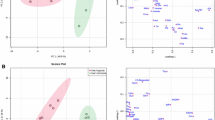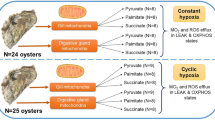Abstract
The present study describes a high anoxia tolerance in an amphibian at high temperature. Indeed, the subterranean salamander Proteus anguinus survived 12 h under anoxia at 12°C. Surprisingly, such experimental conditions did not affect P. anguinus oxidative status while muscles and liver antioxidant enzymes activities decreased under 8 h anoxia and only return to basal level during reoxygenation. To test if such adaptation is common in Urodels, equivalent experimentations have been conducted on another newt: the stream-dwelling Calotriton asper. This latter species exhibited only 1.5 h survival under anoxia in spite of higher antioxidant enzymes activities than P. anguinus. Furthermore, aerobic recovery after 1 h anoxia induced a 30% increase of oxidative damage partly explained by SOD and CAT activities that did not return to control values during reoxygenation, demonstrating a lower capacity to counteract ROS overproduction than P. anguinus. In addition, uncoupling protein (UCP) transcript was for the first time detected, partly sequenced and quantified in amphibian muscles and liver. UCP may be considered as a ROS production attenuator by mediating a discharge of the proton gradient generated by the respiratory chain. The putative role of UCP in post-anoxic oxidative status of both species is discussed.





Similar content being viewed by others
Abbreviations
- AOE:
-
Antioxidant enzymes
- SOD:
-
Superoxide dismutase
- CAT:
-
Catalase
- GPx:
-
Glutathione peroxidase
- TBARS:
-
Thiobarbituric acid-reactive substances
- UCP:
-
Uncoupling protein
References
Aebi H, Lester P (1984) Catalase in vitro. Methods in enzymology. Academic Press, San Diego, pp 121–126
Arsenijevic D, Onuma H, Pecqueur C, Raimbault S, Manning BS, Miroux B, Couplan E, Alves-Guerra M-C, Goubern M, Surwit R et al (2000) Disruption of the uncoupling protein-2 gene in mice reveals a role in immunity and reactive oxygen species production. Nat Genet 26:435–439
Bickler PE, Buck LT (2007) Hypoxia tolerance in reptiles, amphibians, and fishes: life with variable oxygen availability. Annu Rev Physiol 69:145–170
Boutilier RG (2001) Mechanisms of cell survival in hypoxia and hypothermia. J Exp Biol 204:3171–3181
Brand MD (2005) The efficiency and plasticity of mitochondrial energy transduction. Biochem Soc Trans 33:897–904
Bulog B, Mihajl K, Jeran Z, Toman MJ (2002) Trace element concentrations in the tissues of Proteus anguinus (Amphibia, Caudata) and the surrounding environment. Water Air Soil Pollut 136:147–163
Christiansen J, Penney D (1973) Anaerobic glycolysis and lactic acid accumulation in cold submerged Rana pipiens. J Comp Physiol A 87:237–245
Criscuolo F, Gonzalez-Barroso MDM, Maho YL, Ricquier D, Bouillaud F (2005) Avian uncoupling protein expressed in yeast mitochondria prevents endogenous free radical damage. Proc Royal Soc B 272:803–810
Echtay KS, Roussel D, St-Pierre J, Jekabsons MB, Cadenas S, Stuart JA, Harper JA, Roebuck SJ, Morrison A, Pickering S, Clapham JC, Brand MD (2002) Superoxide activates mitochondrial uncoupling proteins. Nature 415:96–99
Hermes-Lima M, Storey KB (1993) Antioxidant defenses in the tolerance of freezing and anoxia by garter snakes. Am J Physiol R 265:R646–R652
Hermes-Lima M, Storey KB (1996) Relationship between anoxia exposure and antioxidant status in the frog Rana pipiens. Am J Physiol R 271:R918–R925
Hermes-Lima M, Zenteno-Savin T (2002) Animal response to drastic changes in oxygen availability and physiological oxidative stress. Comp Biochem Physiol C 133:537–556
Hervant F, Mathieu J, Garin D, Freminet A (1995) Behavioral, ventilatory and metabolic responses to severe hypoxia and subsequent recovery of the hypogean Niphargus rhenorhodanensis and the epigean Gammarus fossarum. Physiol zool 68:223–244
Hervant F, Mathieu J, Garin D, Freminet A (1996) Behavioral, ventilatory and metabolic responses of the hypogean amphipod Niphargus virei and the epigean isopod Asellus aquaticus to severe hypoxia and subsequent recovery. Physiol zool 69:1277–1300
Hervant F, Mathieu J, Barré H, Simon K, Pinon C (1997) Comparative study on the behavioral, ventilatory and respiratory responses of hypogean and epigean crustacean to long-term starvation and subsequent feeding. Comp Biochem Physiol A 118:1277–1283
Hervant F, Garin D, Mathieu J, Freminet A (1999) Lactate metabolism and glucose turnover in the subterranean crusracean Niphargus virei during post-hypoxic recovery. J Exp Biol 205:579–592
Hervant F, Mathieu J, Durand J (2001) Behavioral, physiological and metabolic responses to long-term starvation and refeeding in the blind cave-dwelling (Proteus anguinus) and a surface-dwelling (Euproctus asper) salamander. J Exp Biol 204:269–281
Hochachka P, Somero G (2002) Biochemical adaptation. mechanism and physiological evolution, Oxford university press, New York
Hochachka PW, Buck LT, Doll CJ, Land SC (1996) Unifying theory of hypoxia tolerance: molecular/metabolic defense and rescue mechanisms for surviving oxygen lack. Proc Natl Acad Sci 93:9493–9498
Jastroch M, Wuertz S, Kloas W, Klingenspor M (2005) Uncoupling protein 1 in fish uncovers an ancient evolutionary history of mammalian nonshivering thermogenesis. Physiol Genom 22:150–156
Joanisse DR, Storey KB (1996) Oxidative damage and antioxidants in Rana sylvatica, the freeze-tolerant wood frog. Am J Physiol R 271:R545–R553
Keller PA, Lehr L, Giacobino J-P, Charnay Y, Assimacopoulos-Jeannet F, Giovannini N (2005) Cloning, ontogenesis, and localization of an atypical uncoupling protein 4 in Xenopus laevis. Physiol Genom 22:339–345
Knickerbocker DL, Lutz PL (2001) Slow ATP loss and the defense of ion homeostasis in the anoxic frog brain. J Exp Biol 204:3547–3551
Krowczynska AM, Coutts M, Makrides S, Brawerman G (1989) The mouse homologue of the human acidic ribosomal phosphoprotein PO: a highly conserved polypeptide that is under translational control. Nucleic Acids Res 17:6408
Lushchak VI, Bagnyukova TV (2006) Effects of different environmental oxygen levels on free radical processes in fish. Comp Biochem Physiol B 144:283–289
Lushchak VI, Lushchak LP, Mota AA, Hermes-Lima M (2001) Oxidative stress and antioxidant defenses in goldfish Carassius auratus during anoxia and reoxygenation. Am J Physiol R 280:R100
Lushchak VI, Bagnyukova TV, Lushchak OV, Storey JM, Storey KB (2005) Hypoxia and recovery perturb free radical processes and antioxidant potential in common carp (Cyprinus carpio) tissues. Int J Biochem Cell Biol 37:1319–1330
Lutz PL, Nilsson GE (1997) Contrasting strategies for anoxic brain survival–glycolysis up or down. J Exp Biol 200:411–419
Malard F, Hervant F (1999) Oxygen supply and the adaptations of animals in groudwater. Freshw Biol 41:1–30
Manevich Y, Fisher AB (2005) Peroxiredoxin 6, a 1-Cys peroxiredoxin, functions in antioxidant defense and lung phospholipid metabolism. Free Radic Biol Med 38:1422–1432
Mark FC, Lucassen M, Portner HO (2006) Thermal sensitivity of uncoupling protein expression in polar and temperate fish. Comp Biochem Physiol D 1:365–374
Negre-Salvayre A, Hirtz C, Carrera G, Cazenave R, Troly M, Salvayre R, Penicaud L, Casteilla L (1997) A role for uncoupling protein–2 as a regulator of mitochondrial hydrogen peroxide generation. FASEB J 11:809–815
Ohkawa H, Ohishi N, Yagi K (1979) Assay for lipid peroxides in animal tissues by thiobarbituric acid reaction. Anal Biochem 95:351–358
Ramsey JJ, Harper M-E, Humble SJ, Koomson EK, Ram JJ, Bevilacqua L, Hagopian K (2005) Influence of mitochondrial membrane fatty acid composition on proton leak and H2O2 production in liver. Comp Biochem Physiol B 140:99–108
Rey B, Sibille B, Romestaing C, Belouze M, Letexier D, Servais S, Barre H, Duchamp C, Voituron Y (2008) Reptilian uncoupling protein: functionality and expression in sub-zero temperatures. J Exp Biol 211:1456–1462
Rolfe DFS, Brand MD (1997) The physiological significance of mitochondrial proton leak in animal cells and tissues. Biosci Rep 17:9–16
Ruuge EK, Ledenev AN, Lakomkin VL, Konstantinov AA, Ksenzenko MY (1991) Free radical metabolites in myocardium during ischemia and reperfusion. Am J Physiol R 261:L81–L86
Schwartz TS, Murray S, Seebacher F (2008) Novel reptilian uncoupling proteins: molecular evolution and gene expression during cold acclimation. Proc Royal Soc B 275:979–985
Sies H (1991) Oxidative stress: oxidants and antioxidants. Academic Press, San Diego
Sluse FE, Jarmuszkiewicz W, Navet R, Douette P, Mathy G, Sluse-Goffart CM (2006) Mitochondrial UCPs: new insights into regulation and impact. Biochim Biophys Acta 1757:480–485
Storey KB (1996) Oxidative stress: animal adaptations in nature. Braz J Med Biol Res 29:1715–1733
St-Pierre J, Buckingham JA, Roebuck SJ, Brand MD (2002) Topology of superoxide production from different sites in the mitochondrial electron transport chain. J Biol Chem 277:44784–44790
Stuart JA, Harper JA, Brindle KM, Brand MD (1999) Uncoupling protein 2 from carp and zebrafish, ectothermic vertebrates. Biochim Biophys Acta 1413:50–54
Viarengo A, Burlando B, Cavaletto M, Marchi B, Ponzano E, Blasco J (1999) Role of metallothionein against oxidative stress in the mussel Mytilus galloprovincialis. Am J Physiol R 277:R1612–R1619
Voituron Y, Servais S, Romestaing C, Douki T, Barre H (2006) Oxidative DNA damage and antioxidant defenses in the European common lizard (Lacerta vivipara) in supercooled and frozen states. Cryobiology 52:74–82
Willmore WG, Storey KB (1997) Antioxidant systems and anoxia tolerance in a freshwater turtle Trachemys scripta elegans. Mol Cell Biochem 170:177–185
Acknowledgments
This research was supported by funds from University Claude Bernard-Lyon I and the National Centre for French Scientific Research (CNRS). The authors thank Jacqueline Pequignot for her valuable assistance in enzyme activity assays, Lara Koneckny for her helpful support in transcript sequencing and Dr. Alexis Chaine for his assistance in checking a first version of the manuscript. The present investigation was carried out according to the ethical principles of the French (Ministère de l’Agriculture) and European Convention for the Protection of Vertebrate Animals Used for Experimental and Scientific Purposes (Council of Europe, no. 123, Strasbourg, 1985).
Author information
Authors and Affiliations
Corresponding author
Additional information
Communicated by G. Heldmaier.
Rights and permissions
About this article
Cite this article
Issartel, J., Hervant, F., de Fraipont, M. et al. High anoxia tolerance in the subterranean salamander Proteus anguinus without oxidative stress nor activation of antioxidant defenses during reoxygenation. J Comp Physiol B 179, 543–551 (2009). https://doi.org/10.1007/s00360-008-0338-9
Received:
Revised:
Accepted:
Published:
Issue Date:
DOI: https://doi.org/10.1007/s00360-008-0338-9




